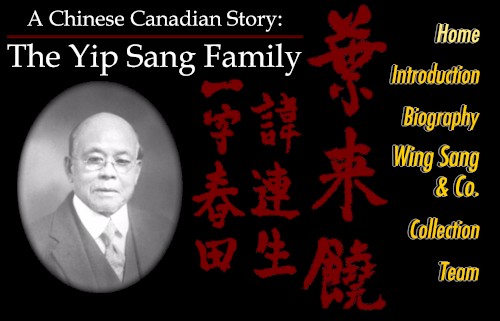Topic #4 Migration

Time: 3-6 period(s)
Objectives:
- Students will recognize that Canada is a
multicultural country made up of people with a
variety of languages, religions, and customs.
- Students will examine the influences of
immigration and emigration on the make up of
Canada's population.
- Students will discuss the push and pull factors
of different immigrants coming to Canada.
- Students will recognize the contributions made by
people from other countries to Canadian society.
- Students will be able to apply simple statistical
analysis tools to analyze a set of data.
- Student will be able to synthesize and draw
conclusions from recorded information.
- Students will become comfortable with
interpreting and using information from the World
Wide Web.
Resources:
- Digital Collections: A Chinese-Canadian Story:
The Yip Sang Family
( http://www.schoolnet.ca/collections/yipsang/
) or East to West: The Story of Japanese
Settlement in Southern Alberta
( http://www.schoolnet.ca/collections/japanese/
).
- Geography textbook which contains Canada's
immigration criteria and point system
- Heritage foundation resources, including Heritage
Minutes video clips.
Purpose: To look at natural change in a
population compared to change as a result of migration
and to examine where people have come from and why.
Ideas:
- Introduce the idea of migration by discussing the
fact that the natural factors that can make a
population shrink or grow are the birth and death
rates. Both of these factors have been steadying
in recent years at very low levels. Therefore,
any major changes in the number, distribution,
and composition of Canada's people is the result
of migration. The most significant changes result
from people entering and leaving the country.
Define the terms immigrate and emigrate.
Immigrate: - to enter another country to live there
permanently.
Emigrate: - to leave a country to live permanently in
another.
Have students examine a time graph for immigration and
discuss why there are certain peaks in immigration and
why there are drops in immigration over the last century.
Discuss the effect of free land, economic hardship (The
Great Depression), government policies, and war on
immigration numbers.
- There have been great changes in the number of
immigrants, where they come from, their religion,
their language, and their reasons for coming.
Each immigrant contributes to cultural diversity
in Canada, making it a multicultural society. A
multicultural society is a society that accepts
and promotes diversity in language, culture,
common governance, and heritage. Have students
discuss, in a circle, the benefits and challenges
of having a multicultural mosaic compared to a
melting pot. Discuss the different ways Canada
promotes multiculturalism and discourages the old
practices such as assimilation.
- Discuss the various reasons why people migrate.
These reasons can be put into two categories,
push factors and pull factors. Push factors are
those factors that push a person from their
current country and pull factors are factors that
pull a person to the new country. Examples of
push factors include war, famine, disease, lack
of religious freedom, government policies, and
unemployment. Some pull factors include,
education, employment, democracy, freedom of
religion, and health care.
- Have students investigate the digital collection A
Chinese-Canadian Story: The Yip Sang Family (
http://www.schoolnet.ca/collections/yipsang/
) or East to West: The Story of Japanese
Settlement in Southern Alberta
( http://www.schoolnet.ca/collections/japanese/
). Students can be asked to determine the
push-pull factors for the Japanese or Yip Sang.


- Display several old photographs of immigrants
coming to Canada in the early years or have
students look at the Web site Canadian Portraits
of Immigrants
( http://www.schoolnet.ca/collections/portraits/docs/imm/enatimm.htm
). Have students write a creative story about the
immigrants' journey to Canada, their reasons for
coming and what their new life in Canada is going
to be like.

- As a class, generate interview questions for
someone who has immigrated to Canada. Four
categories of questions are: personal, life in
country of origin, the decision to leave and the
move, and life in Canada. Once the list of
questions has been created, have students
interview someone they know, a friend or a family
member, who has immigrated to Canada. Have each
student share the story about the person he/she
interviewed with the class and write the story of
the person she/he interviewed.
- Have students come up with the different criteria
they think should be used in determining whether
someone would be permitted to immigrate to
Canada. Have students use a scale to rate which
ones they think are more important and which
criteria are less important. Compare the
students' "immigration criteria" to the
actual immigration criteria.
- Role Play. Have students' role play the different
roles in the immigration process according to
Canada's immigration policy. Some students can
play the role of the immigration officials,
others can role play the immigrants seeking
permission to enter into Canada and other
students can play family members who are
sponsoring the immigrant. The students playing
the independent applicant should have a specific
list of qualities for the screening process or
points test. The possible immigrant has to state
her/his "case" for migrating to Canada
and the immigration officials have to decide
whether or not the person will be allowed to move
to Canada. This role playing will bring out a lot
of key concepts like the points test, the family
category vs. the independent applicant, and a
sponsor. These can be discussed in greater detail
at the end of the role play exercise. This
activity can be found in the Heritage Foundation
Education Materials.
Evaluation:
- Evaluate student participation in class
discussions.
- Mark students' push and pull factors for either
Yip Sang or the Japanese.
- Evaluate the story each student told about the
person he/she interviewed.
- Evaluate students' participation and role
playing.
|
